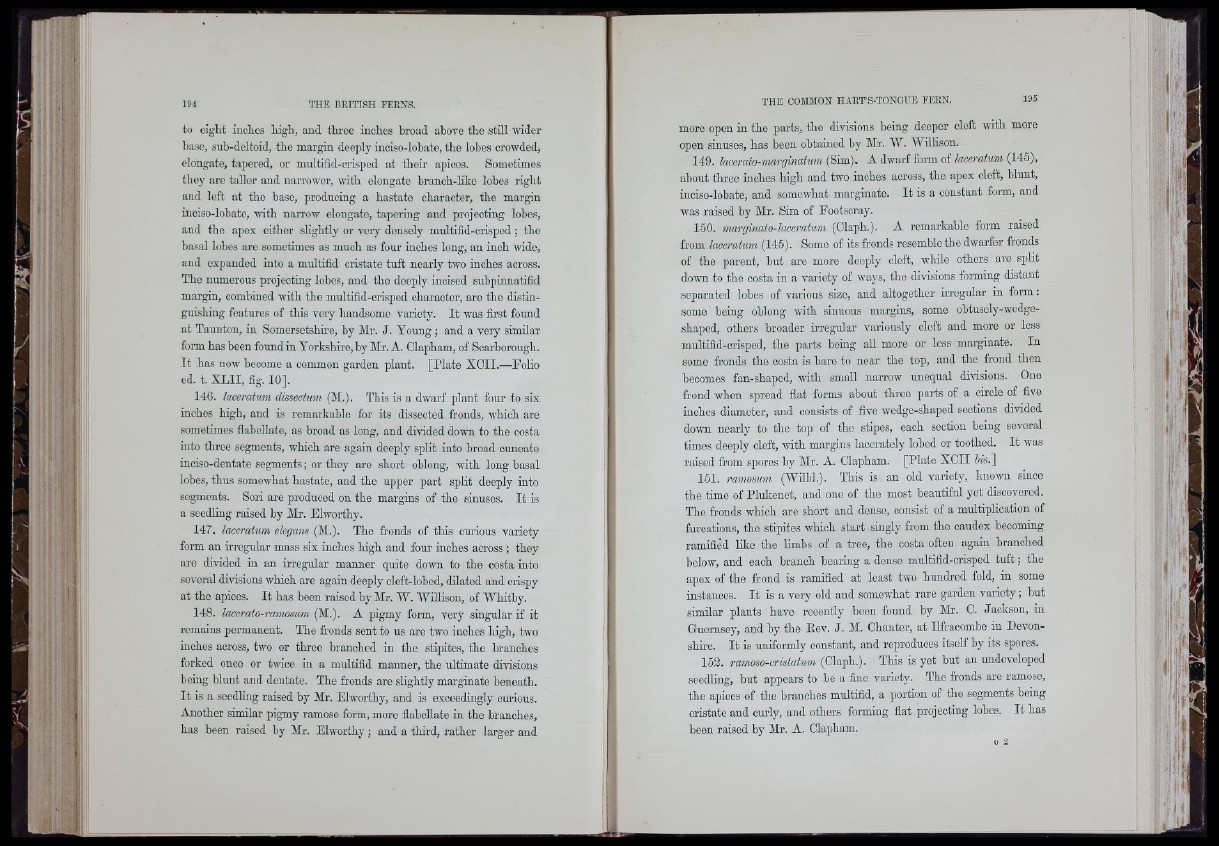
to eight inches high, and throe inches broad above the still wider
base, sub-deltoid, tho margin deeply inciso-lobate, the lobes crowded,
elongate, tapered, or multifid-orisped at their apices. Sometimes
they are taller and narrower, with elongate branch-like lobes right
and left at tho base, producing a hastate character, the margin
inciso-lobate, ■ndth naiTow elongate, tapering and projecting lobes,
and the apex either slightly or very densely multifid-orisped; tho
basal lobes are sometimes as much as four inches long, an inch wide,
and expanded into a multifid cristate tuft nearly two inches across.
Tho numerous projecting lobes, and the deeply incised suhpinnatifid
margin, combined with the multifid-crisped character, are the distinguishing
features of this very handsome variety. It was first found
at Taunton, in Somersetshire, by Air. J. Young ; and a very similar
form has been found in Yorkshire, by Air. A. Clapham, of Scarborough.
It has now become a common garden plant. [Plate XCII.—Folio
ed. t. XLII, fig. 10].
146. laceratum dissectum (AI.). This is a dwarf plant four to six
inches high, and is remarkable for its dissected fronds, which are
sometimes flabellate, as broad as long, and divided down to the costa
into three segments, which are again deeply split into broad cuneate
inoiso-dentate segments; or they are short oblong, with long basal
lobes, thus somewhat hastate, and the upper part spKt deeply into
segments. Sori are produced on the margins of the sinuses. It is
a seedling raised by Air. Elworthy.
147. laceratum elegans (AI.). The fronds of this curious variety
form an irregular mass six inches high and four inches across ; they
are divided in an irregular manner quite down to the costa into
several divisions which are again deeply cleft-lohed, dilated and crispy
at the apices. It has been raised by Air. AY. AYiUison, of AATiitby.
148. lacerato-ramosum (AI.). A pigmy form, very singular if it
remains permanent. The fronds sent to us are two inches high, two
inches across, two or three branched in the stipites, the branches
forked once or twice in a multifid manner, the ultimate divisions
heing blunt and dentate. The fronds are slightly marginate beneath.
It is a seedling raised by Air. Elworthy, and is exceedingly curious.
Another similar pigmy ramose form, more flabellate in the branches,
has been raised by Air. Elworthy; and a third, rather larger and
more open in the parts, the divisions being deeper cleft with more
open sinuses, has been obtained by Air. AV. AVilUson.
149. lacerato-marginatum (Sim). A dwarf form of laceratum (145),
about threo inches high and two inches across, the apex cleft, blunt,
inciso-lobate, and somewhat marginate. It is a constant form, and
was raised by Air. Sim of Footscray.
150. marginato-laceratum (Claph.). A remarkable form raised
from laceratum (145). Some of its fronds resemble tho dwarfer fronds
of the parent, hut aro more deeply cleft, while others are spUt
down to the costa in a variety of ways, tho divisions forming distant
separated lobes of various size, and altogether irregular in form:
some being oblong with sinuous margins, some obtusoly-wodge-
shaped, others broader irregular variously cleft and more or less
multifid-orisped, the parts being all more or less marginate. In
some fronds the costa is bare to near the top, and the frond then
heeomes fan-shaped, with small narrow unequal divisions. One
frond when spread flat forms about three parts of a circle of five
inches diameter, and consists of five wedge-shaped sections divided
down nearly to the top of the stipes, each section being several
times deeply cleft, with margins lacorately lobed or toothed. It was
raised from spores by Air. A. Clapham. [Plate XCII Ws.]
151. ramosum (AVilld.). This is an old variety, known sinco
the time of Plukenet, and one of tho most beautiful yet discovered.
The fronds which are short and dense, consist of a multiplication of
furcations, the stipites which start singly from the caudex becoming
ramified Klcc the limbs of a tree, the costa often again hranohed
below, and each branch hearing a dense multifid-orisped tu ft; the
apex of the frond is ramified at least two hundred fold, in some
instances. It is a very old and somewhat rare garden variety; but
similar plants have recently been found by Air. C. Jackson, in
Guernsey, and by the Rev. J. AI. Chanter, at Ilfracombe in Devonshire.
It is uniformly constant, and reproduces itself by its spores.
152. ramoso-eristatum (Claph.). This is yet hut an undeveloped
seedling, hut appears to be a fine variety. Tho fronds are ramose,
the apices of the branches multifid, a portion of the segments being
cristate and curly, and others forming flat projecting lobes. It has
been raised by Air. A. Clapham.
0 2
* 1
i il
Ú
I’ I.
■‘RI
:,(l
É á
, l | 4
M l